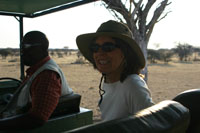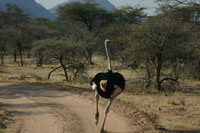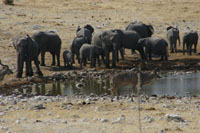Into the Namib
The aircraft-eye view descending into Windhoek is flat, yellow-tan stony soil extending in all directions, with dull, grey-green scrub thorn dotted about. Dirk de Bod and his brother in law Gyss meet us, and we make the hour’s jolting journey over hard dirt roads into the bush. The countryside turns a bit more rolling hills, with some interesting rocky outcroppings—kopjes—and masses of low desert scrub thorn and acacia—all dull grey-smoke brown in this winter, or dry season of August. On the way in, we spot yellow-breasted rollers, kori bustard, francolin, kudu, gemsbock and lots of wart hogs.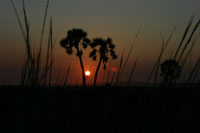 As the sun descends dull-red into the dusk, we arrive at Dirk’s hunting camp-Ingadine Lodge--in the Khomas Hochsland of Namibia (after, of course the obligatory 1.5 day trip from the West Coast to get to southern Africa). A lovely spot on a water hole with a lodge, fire-pit terrace, and three very well appointed permanent tents—slate floored bathroom, veranda, comfy bed and nicely “bush” decorated. Sundowners at the neighboring farmers ridge-top terrace, toasting the blood orange orb below the horizon in the gathering gloom, then back to dinner fixed by Gyss’ wife Maryana—blue wildebeest rouladen with mushrooms on rice, salad and sticky toffee pudding, washed down with Zonnenbloom Stellenbosch Merlot 2002. After dinner, we sip a brandy around a warming fire (the “bushman’s TV, Jack calls it) in the quite chilly night air, looking up at the crystal-sharp stars of the Southern hemisphere and absorbing the night noises on our first night in the bush.
As the sun descends dull-red into the dusk, we arrive at Dirk’s hunting camp-Ingadine Lodge--in the Khomas Hochsland of Namibia (after, of course the obligatory 1.5 day trip from the West Coast to get to southern Africa). A lovely spot on a water hole with a lodge, fire-pit terrace, and three very well appointed permanent tents—slate floored bathroom, veranda, comfy bed and nicely “bush” decorated. Sundowners at the neighboring farmers ridge-top terrace, toasting the blood orange orb below the horizon in the gathering gloom, then back to dinner fixed by Gyss’ wife Maryana—blue wildebeest rouladen with mushrooms on rice, salad and sticky toffee pudding, washed down with Zonnenbloom Stellenbosch Merlot 2002. After dinner, we sip a brandy around a warming fire (the “bushman’s TV, Jack calls it) in the quite chilly night air, looking up at the crystal-sharp stars of the Southern hemisphere and absorbing the night noises on our first night in the bush.
Next morning, we follow a sandy track that winds out through the tawny-yellow grass and shrub acacia countryside, dipping occasionally into sandy dry river courses. We spot springbok, a small herd of red impala, and a yellow-billed hornbill perching in a skeleton-like dead tree. Bethwell, our driver/guide points out female ostrich, blesbok-regular and albino, and a trio of warthogs as we approach a rocky pass through two hills. In the reservoir below, we see the broad backs, tiny eyes and wiggling ears of two pink-grey hippos, sunning them at the surface. As we wind slowly along the rocky pass-track, the male baboons spring from the grassy hill, hoot and bound over the track and vehicle. Through the pass, we wander on, spotting more springbok, a small herd of blue wildebeest, then a group of female kudu fading into the bushy shadows. The steep escarpment angled with great granite slabs and rows of faceless giant’s dominos, drops to a high plain that stretches to the far purple-hazy tabletop Etjo Mountains. Red ochre clay soil, tawny yellow grass, buff sand riverbeds and dull smoke gray flat-topped acacias, and the occasional taller greener forms of acacia stretch to the infinity of the far mountains, a limited palate, but a magical, beautiful landscape. We spot a family of white-striped chestnut nyala, more sweeping-horned oryx, and a few fuzzy waterbuck, with eh white bulls eye on their rumps. 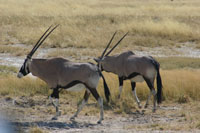
Dropping through another dry riverbed, Bethwell cautions quiet and 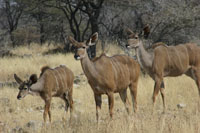 sharp eyes—we’re in rhino territory. The 6x6 growls slowly through the grassland, then he stops and whispers “rhino”. None of us can see them, so we inch closer. There! Huge! The green-gray of old faded army camo—one large and two smaller female white rhinos—enormous bulldozer bodies, long head, low to the ground, wide snout, dripping nostrils, tiny, low set beady eyes, and bit twitching ears and great scimitar horns. With very poor eyesight, they can’t see us, but their acute hearing and smell give us away, upwind as we are. They move, and we circle slowly around them till we are head on, no more than 20 meters away. Sure seems like a chargeable distance, but the seem placid. Scything their low heads back and for the, they move around amicably, the younger two mock-jousting a bit. After fifteen minutes of quiet, up close and personal, they amble off, and we set out back lodge-ward. The sun is dropping into the western ridge, shadow lengthening, and the light going that perfect warm orange for wildlife photography. At the lodge, we rinse the day away with tall gin & tonics, and recount individual tales, Dinner in the round, domed “boma” with roaring firepit at center is a bit contrived—sort of like those old Henry VII medieval dinner restaurants from the 70’s. The usual salad buffet, iron pots of mostly overcooked vegetables, and arrayed on a grate, atop an enormous circular barbecue are kudu sausages, redolent of fennel seed and mace, pork ribs, roasted loin of Oryx, and springbok stew. The springbok is delicious, kudu interesting, Oryx tough and without much flavor.
sharp eyes—we’re in rhino territory. The 6x6 growls slowly through the grassland, then he stops and whispers “rhino”. None of us can see them, so we inch closer. There! Huge! The green-gray of old faded army camo—one large and two smaller female white rhinos—enormous bulldozer bodies, long head, low to the ground, wide snout, dripping nostrils, tiny, low set beady eyes, and bit twitching ears and great scimitar horns. With very poor eyesight, they can’t see us, but their acute hearing and smell give us away, upwind as we are. They move, and we circle slowly around them till we are head on, no more than 20 meters away. Sure seems like a chargeable distance, but the seem placid. Scything their low heads back and for the, they move around amicably, the younger two mock-jousting a bit. After fifteen minutes of quiet, up close and personal, they amble off, and we set out back lodge-ward. The sun is dropping into the western ridge, shadow lengthening, and the light going that perfect warm orange for wildlife photography. At the lodge, we rinse the day away with tall gin & tonics, and recount individual tales, Dinner in the round, domed “boma” with roaring firepit at center is a bit contrived—sort of like those old Henry VII medieval dinner restaurants from the 70’s. The usual salad buffet, iron pots of mostly overcooked vegetables, and arrayed on a grate, atop an enormous circular barbecue are kudu sausages, redolent of fennel seed and mace, pork ribs, roasted loin of Oryx, and springbok stew. The springbok is delicious, kudu interesting, Oryx tough and without much flavor.
Leaving Etjo, we head northeast for Otavi. The sky is hazy with dust and maybe some smoke, through slightly rolling hills, past the sharper escarpment of the Waterberg plateau slightly visible in the haze. We will drop altitude slightly from the 5500 feet or so of Etjo to around 3000 ft at Etosha. We pass through Otjiwarango, then Otavi, and stop around 1 for a rather Germanic lunch at Gretchen’s café and biergarten in Tsumeb—a clean, manicured german-colonial town. Another hour northwest brings us to the turnoff just outside of Etosha National Part to the Etosha Aoba Lodge. 10 km wandering a rutted track back into the dusty scrub bush brings us to the lodge—a delightful oasis. A large central thatched boma with bar, sitting and dining area, terrace and firepit overlooking a small waterhole, a small, cold and refreshing pool, and a dozen delightfully appointed and decorated bungalows of beam, wattle and thatch. On the way in we spot steenbok, did-did, duikers and, lordy, an 8 foot black mamba edging into the road. As we approach, it rears and dives back into the bush. Report of the mamba sighting sets Peter and Anya, the young managers, back a bit, as their daughter has been wandering about that area. While not rare, mambas are no longer commonplace, and their mean and aggressive disposition makes them well feared. 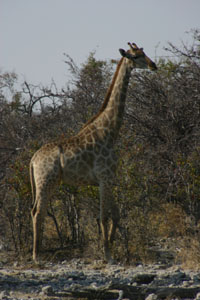 Up at the crack of dawn, and off at sunrise into Etosha, entering by the eastern Von Lindequist gate after a detour to the Klein Namutoni waterhole, where we are rewarded with sightings of giraffe, eland, kudu and black-faced impala glowing in the early light at the water. A black-backed jackal skulks across the buff, stony soil, and a tawny eagle swoops on a plover for breakfast. Springbok, Oryx and steenbok amble to the water, and we just glimpse a hyena loping off into the scrub.
Up at the crack of dawn, and off at sunrise into Etosha, entering by the eastern Von Lindequist gate after a detour to the Klein Namutoni waterhole, where we are rewarded with sightings of giraffe, eland, kudu and black-faced impala glowing in the early light at the water. A black-backed jackal skulks across the buff, stony soil, and a tawny eagle swoops on a plover for breakfast. Springbok, Oryx and steenbok amble to the water, and we just glimpse a hyena loping off into the scrub.
Etosha National Park, home to 144 species of animals and 370 types of birds, covers 22,000 square KM in a dead flat, desolate expanse of shimmering terrestrial heat, broken only by sarb thorn in the west, and the Mopane woods that stand in the eastern sector. Vince performs park check-in duties while we climb the tower at Fort Namutoni (where in 1904, seven Germans held off 5,000 attacking Ovambo warriors for a full day, until they could escape after darkness). The tower provides a panoramic 360-degree view of Etosha Park—flat as Kansas as far as the eye can see. 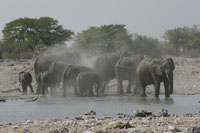
Bouncing along the rutted track we spot Burchell’s zebra, many glorious-hued lilac-crested rollers, deep turquoise –shouldered glossy starlings, yellow-billed hornbills, pretty crested grey lourie, or “go-away bird” named for its call 'kweh-h-h-h' or 'go-way-y-y', red-billed francolin, namaqua sandgrouse, and helmeted guinea fowl. Chudup (black mud) waterhole holds another dozen giraffe, as well as the usual suspects, and Goas, which we approach late morning, holds two dozen or more lovely elephants. They are just arriving at the hole, and plunge in, throwing and spouting and kicking water, snorting, rolling in the mud edge—there are a half dozen babies, ranging from a tiny 2-3 month old, through yearlings. They trot along the water’s edge, swinging their trunks, then dive in, root around, burrow under their mothers or aunts and just have a smashing time. Great grey bodies, chocolate-milk mud, clouds of smoky dust, gouts of water and great trumpeting. After they’ve frolicked and bathed, they move to the other waterhole and 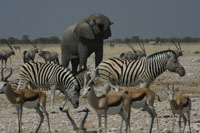 placidly drink—not stirring up a bit of mud in their drinking-fountain hole.
placidly drink—not stirring up a bit of mud in their drinking-fountain hole.
In the afternoon, we head out to the Etosha Pan overlook. On the way, Vince spots fresh tracks of lion—quite a few—headed toward Nuanses hole—we will investigate as day fades. Etosha Pan is a huge alkali salt flat—a depression in the earth some 3-6 feet deep. Etosha means “great white place”—it’s actually grayish, and looks like a flat, calm sea disappearing to the northern horizon. 75 x 110 km in area, it’s entirely devoid of fauna, and dry all year except briefly after the rains, when it shimmers blue-green and teems with pink flamingos and snowy white pelicans. Driving into the pan to the lookout point feels like driving out into the Gulf of St Malo at low tide. Returning to Nuanmses as the sun is dropping horizon-ward, we sit watching the hole, when we notice motion in the grass behind us—a majestic male lion striding around the side—soon his pride comes out to joint him—three females and 10 cubs—yearlings or so—they make their way to the water, drink, then lounge, roll and play in the tawny grass as the shadows lengthen. Four cubs of one mother nuzzle up under her, two to a side, to nurse—she sits placidly upright, looking serene (or bored) until she shoves them aside and flops over. The male sits, sphinx-like in the grass on a rise above the hole and surveys his family and domain. 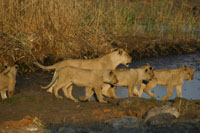
Friday morning after a quick breakfast, we toodle off in the cool early air for a series of water holes—Reitfontein is almost deserted, but Charitsaub holds the usual suspects and hundreds of zebra—they’re all over the roads, as well—but without their normal wildebeest companions. At Suede there are a couple dozen elephants, whose spoor we’ve tracked in. They drink, snort and mill around—several babies darting in and out of the mom’s and aunties’ legs.
This area is mostly flat, open plains, short yellow grass, some very low reddish groundcover and occasional large acacia trees. Plains game are everywhere, along with jackals, a trio of spotted hyenas, and warthogs. At Homob, a beautiful setting with rocks and bunchgrass around the waterhole, plains leading to the pan in the distance, a parade of zebra, springbok, kudu and hartebeest all noisily enter the pool to drink. A black-breasted snake eagle overlook the water from an acacia perch, and a pair of pied crows preen on a rock pillar. 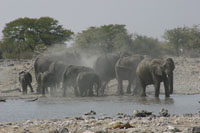 Salvadora also holds a herd of elephant—20 or so—and the babies roll and play, cavort, chase each other around the edge. One auntie stands with a leg cocked and trunk curled back onto her forehead, as if to say “oh, my” and another rocks gently from side to side.
Salvadora also holds a herd of elephant—20 or so—and the babies roll and play, cavort, chase each other around the edge. One auntie stands with a leg cocked and trunk curled back onto her forehead, as if to say “oh, my” and another rocks gently from side to side.
Herds and herds line and dot the road as we tool into the Gemsbokulakte (oryx flats) hole, which is itself packed with all the plains game—dozens and dozens of everything milling about, approaching the water, guzzling and generally hanging about. A lone bull elephant approaches across the plain at a fast walk, trumpeting his arrival and soon zebras, springbok and kudu burst out of the hole. He finds the feeder pipe and puts his trunk-end right over it to drink his fill of the freshest water. The bull moves away a bit, and a lone male ostrich, wings spread in display, approaches and stands right in the elephant’s spot over the pipe end, drinking away. The elephant, enraged, mock charges, but the ostrich stands his ground, displays and won’t back down. Amazingly, the elephant does! Intimidated by a big bird. Vince can’t believe it. We theorize that maybe he was kicked hard as a youngster by an ostrich (they can kick through the side of a car, it is said).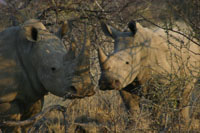
We plow through zebras, springbok and hartebeest, past more giraffes and spot white-quilled Karhaan, guineafowl, sand grouse and bustards on the way to camp at Okaukuejo.
Afternoon is not too successful—we head NW along the pan’s edge to Leeubron (which proves dry) and then Okandeka, where there are very fresh lion tracks, but no cats to be seen. We catch a curious mating dance of two ostriches, and sight a nesting pair of greater kestrels, and a close pair of black-backed jackals silhouetted against the blood-red orb of the setting sun. We return to camp to find Dirk and Jack, returned from their Kudu hunt awaiting us at the bar with cooling gin and tonics.
The water hole at Okaukuejo camp is pretty spectacular—it’s actually world-renowned. After a tasty dinner of eland oxtail stew and gemsbok, we troop over to the hole, red wine and jaegermeister in hand. Barren at first—nothing in the floodlit rocky moonscape. Dozens of viewers, all quiet, waiting. Slowly, out of the distance a barely visible grey shape—palm frond ears around funnel-shaped nose—emerges, and an elephant moves purposefully to the water. After five minutes, another arrives. They circle the hole, and then “high five” trunks in greeting. Then 2-3 more every 5-10 minutes, until there are a couple of dozen pachyderms drinking, nuzzling, butting heads. Dirk points to a tiny grey dot on the horizon in another direction and whisper “rhino”. The pre-historic best plods carefully forward, sniffing, moves to the hole to drink. The biggest elephant, a huge bull—challenges the rhino, which wheels and trots back 20 yards. He stands, sniffing, waiting. Another rhino slowly emerges. The two males face off—move toward each other, snort and bellow. Without ever touching, one backs off, moves toward the water. A young elephant challenges him, and he inches backward. The two rhino move around the arena, and face off again—slowly, inching toward each other. Snorting and screaming, they almost, but never actually touch. One backs off again, turning away. A rhino cow and 2-3 year old calf approach. The bigger male trots in front of the hole toward us—not 10 yards away—an amazing, awesome sight. A fifth and sixth rhino move in. Four are at the water, drinking. The big bull elephant charges, trumpets, screams. The rhino back off. This is interesting, as an elephant cannot really hurt a rhino—they are too fast—but a rhino can gut an elephant with a swipe of his horn. There are now around 30 elephants at the hole, six black rhino, one of the world’s rarest animals, in an unworldly, ghostly tableau, with the counterpoint of furtive black-backed jackals creeping amongst the low rocks. 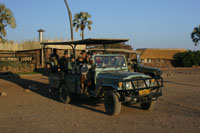 Another day and we are up early and into open canvas-topped land cruisers—off across the wide red-rock plains into river wash valleys, and down the Aub Canyon, careening across dry watercourses and up the spectacular Van Zylsgat box canyon, replete with waterfall. We bounce up, down, across for a couple of hours til we park in the shade of a Mopane, and the trackers set out on foot, looking for rhino sign. In a half hour they return, and we set off, single file, 3 guides, six seekers, up and down dry streambeds, across fields littered with thousands of red sandstone bowling-ball rocks, in and around spiky thorn.
Another day and we are up early and into open canvas-topped land cruisers—off across the wide red-rock plains into river wash valleys, and down the Aub Canyon, careening across dry watercourses and up the spectacular Van Zylsgat box canyon, replete with waterfall. We bounce up, down, across for a couple of hours til we park in the shade of a Mopane, and the trackers set out on foot, looking for rhino sign. In a half hour they return, and we set off, single file, 3 guides, six seekers, up and down dry streambeds, across fields littered with thousands of red sandstone bowling-ball rocks, in and around spiky thorn.
At a point the lead tracker signals to stop, and for absolute silence, then slowly motions us, one by one, very slowly to him. A huge grey rock of a rhino is lying in the Mopane shade, thirty yards away. The wind is wrong, he senses us, rises, and trots off. The guide motions us to circle down into a streambed and around, then we climb up the bank, inch a few yards along, and there before us is a grey, re-historic tank of 4 tons, twenty yards away, butt to a tree and facing our group. He moves his head around, sways from one front foot to the other, paws the ground, and snorts. I’m sure he’s going to charge us. His dagger-sharp front horn must be 30 inches long! He sways and sniffs for 5-10 minutes, paws again, turns his head, and trots off up the 20-degree slope behind like it wasn’t there. He turns on the ridge, faces us a final time, and trots off down the ridgeline. Absolutely amazing. I’m sweating from both heat and adrenaline—we have “walked up” a rhino. 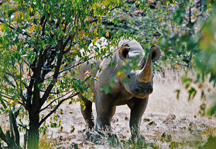
The group trudges back in the mid-day heat, spotting him once more dipping down the ridgeline, and arrive back at the land cruiser to have bush lunch. Camp chairs, a low table, covered in meats, cheeses, bread, with cold beer to wash it down, followed by shaded relaxing, recollecting the amazing experience. After lunch we motor over hill and dale looking for desert elephant. We spot a big group of male kudu, lots of mountain zebra, springbok, oryx, giraffe, Marshal’s eagle and jackal, broken field running after a rabbit, and relatively fresh elephant tracks—but no elephant. We wind slowly back over a couple of hours to Palmwag, and the elephant is in camp! Contentedly munching tall grass and trees. Next morning, he (or another one, who knows) is right outside our hut—cracking branches off a tree 10 feet away. He soon moves off into the oasis and “poses” for some up-close personal photos with Jack and I (each of us standing 20 yards in front of him, nervously looking back, while the other takes a photo).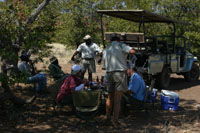 Some days later, Sunday has us up and off relatively late, heading northwest across the gravel plains and schist hills of the northern Namib section, through Spreutshoogie Pass, onto the central highland rolling hills, featuring taller bushgrass, deep yellow and waving in the wind, greener scrub and candle thorns, raisin bushes, aloe and camphor bushes. We top out Gansberg Pass at 5900 feet, and stop for lunch of Eland steaks in the Cheetah Bar at Melrose Lodge, plonked dead in the midst of the highland plain. Arrival at Windhoek and check into Villa Verdi guesthouse mid-afternoon. After an hour’s overview tour of Windhoek, we alight at Joe’s—the most famous game restaurant in Namibia. Rambling, ramshackle thatched structure, central round bar, open beer garden, undulating open thatch-pole dining room, gravel floor and dark tables, a couple of open firepits to ward off the evening chill. We take a big round table next to a firepit, Dirk’s wife Rina and a friend and fellow ph called Michael soon join us and the party begins. The menu, of course runs to meat and game—huge steaks—kudu, oryx, zebra, springbok, crocodile. Dirk, Jack and I, on Dirk’s recommendation. order the “game knuckle” which turns out to be a kudu shank of about three pounds—slow braised in red wine til tender—rich and tasty—accompanied by traditional potato fritters and Pinotage South African varietal red wine. We take a jaegermeister as digestif, and then, per tradition, finish the evening, and our first Namibian adventure with Amarula fruit liquer,the very thing to send us off to the land of nod before a next day departure for the return stateside.
Some days later, Sunday has us up and off relatively late, heading northwest across the gravel plains and schist hills of the northern Namib section, through Spreutshoogie Pass, onto the central highland rolling hills, featuring taller bushgrass, deep yellow and waving in the wind, greener scrub and candle thorns, raisin bushes, aloe and camphor bushes. We top out Gansberg Pass at 5900 feet, and stop for lunch of Eland steaks in the Cheetah Bar at Melrose Lodge, plonked dead in the midst of the highland plain. Arrival at Windhoek and check into Villa Verdi guesthouse mid-afternoon. After an hour’s overview tour of Windhoek, we alight at Joe’s—the most famous game restaurant in Namibia. Rambling, ramshackle thatched structure, central round bar, open beer garden, undulating open thatch-pole dining room, gravel floor and dark tables, a couple of open firepits to ward off the evening chill. We take a big round table next to a firepit, Dirk’s wife Rina and a friend and fellow ph called Michael soon join us and the party begins. The menu, of course runs to meat and game—huge steaks—kudu, oryx, zebra, springbok, crocodile. Dirk, Jack and I, on Dirk’s recommendation. order the “game knuckle” which turns out to be a kudu shank of about three pounds—slow braised in red wine til tender—rich and tasty—accompanied by traditional potato fritters and Pinotage South African varietal red wine. We take a jaegermeister as digestif, and then, per tradition, finish the evening, and our first Namibian adventure with Amarula fruit liquer,the very thing to send us off to the land of nod before a next day departure for the return stateside.
